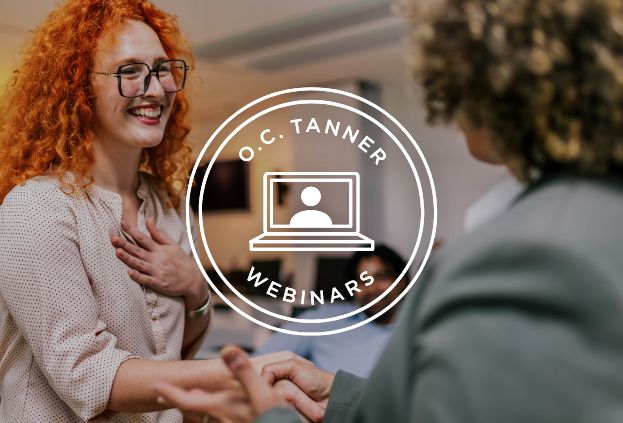How Employee Recognition Shapes Workplace Culture and the Employee Experience

Updated on
January 29, 2025
29
January
2025
It might seem small but saying “thank you” at work can have a big impact on your employee experience and company culture.
Perhaps that sounds like a bold statement, but there is plenty of research to back it up. Employee recognition is one of the most powerful things your company can use to improve motivation, performance, and connection at work.

Understanding employee recognition
Employee recognition is the act of acknowledging and rewarding an employee for their contribution, effort, or innovation. The best recognition comes from a variety of sources— peers, leaders, business partners, or even customers.
Uncover the basics of employee recognition in our beginner’s guide.
Recognition is typically given as verbal or written praise, posts on internal or external social media, or through tangible rewards like bonuses, awards, trophies, or points that can be redeemed for gifts or gift cards.
It’s most effective when it’s integrated. In contrast to sporadic appreciation that isn’t tied to deeper elements of your company culture, integrated recognition is fully ingrained in the fabric of a company’s and their employees’ daily work and processes.
Integrated recognition is a combination of several actions and behaviours that drive appreciation. We call this the recognition integration model:
- Recognition is an everyday part of company culture
- Recognition programs and technology continually improve
- The organisation recognises both large and small efforts
- Recognition is consistently seen throughout the organisation
- Peer-to-peer recognition is common and frequent
- Recognition experiences are crafted around the individual
- Leaders know the recognition preferences of individuals
- Leaders frequently recognise employees

Dive into five types of employee recognition you can use in your organisation today.
The impact of employee recognition on company culture
Company culture refers to the shared values, behaviours, and beliefs that guide how people within your organisation interact with each other and your customers. In other words, company culture is your company’s personality and character, and it’s often reflected in your mission, objectives, ethics, and expectations.
When we define company culture as employees’ values and behaviours, it’s easy to see how sharing consistent appreciation and recognition can greatly influence your company’s culture. But let’s unpack it a bit more.
Employee recognition is one of the six pillars of company culture—our global workplace research refers to these as Talent Magnets.

Companies that perform well in each of the Talent Magnets—purpose, opportunity, success, appreciation, wellbeing, and leadership—experience less attrition, attract top talent, and see great results:
- 74% more likely to have increased in revenue in the past year
- 7x more likely to have employees do great work
- 11x less likely to have experienced layoffs in the past year
As a major component of building a great company culture, employee appreciation helps create a workplace where employees thrive. Here is how recognition can help your culture:
Boosts morale and motivation
Regular recognition boosts employee morale by making employees feel valued and appreciated. When employees see their efforts and achievements acknowledged, it increases their motivation to perform well and contribute to the organisation's success.
According to recent research from the O.C. Tanner Institute, recognition has a direct impact on morale and motivation:
- 84% of employees say the simple act of giving recognition inspires them to think about better ways to get things done
- Employees are 18x more likely to produce great work if they are recognised
Improves job satisfaction and performance
Recognition reinforces desired behaviours and performance outcomes. When employees know their efforts will be acknowledged, they are more likely to strive for excellence, leading to improved individual and organisational performance.
And, when employees feel their work is appreciated, they are more likely to feel satisfied with their jobs and committed to their roles.
When asked, “What is the most important thing your company could do to cause you to produce great work,” the number one employee response was “Recognise me.”
Ohio Living, a leading healthcare organisation, has invested heavily in employee recognition. The return on that investment? They’ve seen cultural outcomes of improved employee happiness and productivity, and even business outcomes of lower infection rates, lower readmission rates, and happier and healthier patients.
In the words of Ohio Living’s CHRO, Dana Ullom-Vucelich, “The companies that invest in their employees are the ones that end up growing financially and succeeding. Every time we have invested in our employee workforce, we see results. When we build upon and invest in talent, it serves our mission and each of our business outcomes improve—and in the meantime, we retain great people, sustaining this great culture.”
“By having effective recognition solutions in place, we are able to encourage people to align with our mission while demonstrating their own unique work ethic and passion.”
—Dana Ullom-Vucelich, Chief Human Resources & Ethics Officer at Ohio Living
Increases trust and loyalty
Regular recognition fosters trust between employees and leaders. It shows that your organisation values employees, building loyalty and a stronger emotional connection to your company, which also helps reduce turnover and its related costs.
Here’s what the data says about the impact of recognition on turnover:
- Consistent recognition can add 3.5 years to an employee’s tenure
- Employees who feel appreciated are 5x more likely to stay at their organisation
- 53% of employees said they would stay at their jobs longer if their employers showed them more appreciation
- 79% of people who quit cite “lack of appreciation” as their reason for leaving
Ultimately, employee recognition not only benefits your employees but also contributes to a more collaborative, engaged, and successful organisation.
Employee recognition fosters a positive employee experience
The employee experience encompasses every interaction an employee has with your organisation, from the recruitment process to the day they leave the company. This includes their work environment, access to tools and resources, relationships with their colleagues and superiors, and opportunities for growth and development.
Use employee recognition to enhance the employee experience:
Start with a warm welcome at onboarding
New hires are in a vulnerable position—a new job, a new team, new policies, and a new company can be overwhelming. By sharing gratitude and recognition early, you can reassure them they’ve made the right decision to join your organisation.
New hires who work at organisations that share appreciation before, during, and after onboarding are more likely to feel included at your company and want to stay—new hire turnover risk drops by 50% in organisations with integrated recognition.
CIBC, a leading North American financial institution with 45,000 employees, partners with O.C. Tanner to integrate recognition into every phase of its employee lifecycle, starting with onboarding.
On each new hire’s first day, the bank welcomes them with a custom CIBC backpack, branded pin, and points from its “MomentMakers” recognition program. This kit also includes a note to connect the employee to the bank’s purpose and an invitation to give feedback to make the company better.
This early set of experiences not only introduces people to their recognition tools, but helps them feel connected to their leader, teams, and the organisation, from the very beginning.

When employees feel their onboarding process is exceptional, they are 2.5x more likely to be extremely satisfied with their workplace. Companies that utilise a more strategic approach to onboarding see a 32% increase in new employee engagement.
Learn the best ways to add appreciation to your onboarding efforts.
Build connection and community
Ongoing research from Gallup reinforces the benefits of having friendships at work. Employee recognition plays an important role in building these feelings of connection, community, and friendship.
Whether it’s a small thank you between peers, a leader acknowledging an employee’s work in front of the team, or a company-wide announcement, employee recognition encourages employees to share moments of gratitude, celebration, and joy.
Our research shows how impactful these moments can be for everyone in your organisation:
- When recognition happens regularly in teams, the odds of having a strong community increase 508%.
- When teams celebrate birthdays and work anniversaries, the odds of an above-average connection between team members improve 11x.
- When recognition for great work and extra effort is a consistent part of everyday culture, the odds of connection increase 15x.
- When leaders use recognition formally (e.g., work anniversaries, everyday effort, and above-and-beyond programs), the odds of having an above-average connection with leaders increase 25x.
“Workplaces are communities, built around the relationships we have with our peers. When these relationships are strong, they can be a source of energy, learning, and support.”
—Harvard Business Review
By making employees feel valued and appreciated, recognition contributes to a more engaged, motivated, and loyal workforce, ultimately driving organisational success.

Implementing employee recognition in the workplace
Now that you know how recognition can impact your culture and employee experience, how can you get started?
There are many tools and initiatives you can use in your company to jumpstart your own employee recognition program. One of the best ways is investing in employee recognition software. These platforms make it easy to give, receive, and manage employee recognition in your workplace.
Here are some tips for building your employee recognition program:
- Determine your employee recognition criteria. What behaviours and actions do you want to encourage and recognise?
- Get senior leadership buy-in. Like most tools and initiatives, senior leadership support can make or break your employee recognition program.
- Find an employee recognition partner. You don’t have to manage your program alone—an experienced recognition partner can help.
- Train and educate employees and leaders. A program only becomes successful if people know when and how to use it.
Learn more about best practices for implementing an employee recognition program at your organisation.
Transform your company culture and employee experience
A little appreciation can go a long way in transforming your company’s employee experience. From boosting morale and job satisfaction, to improving retention and connection, employee recognition is a powerful tool in your toolbox. Take the first steps today to start (or refresh) your employee recognition strategy.
O.C. Tanner is the global leader in software and services that improve workplace culture through meaningful employee recognition experiences. Learn more at octanner.com.



